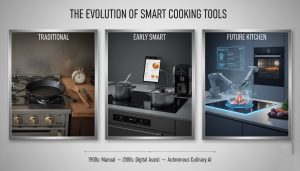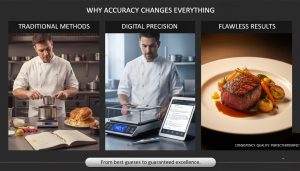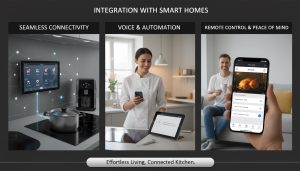When I first started baking, my “measurement system” was a mix of cups, spoons, and wild guesses. The result? Cookies that sometimes doubled as paperweights. That changed when I bought my first smart kitchen scale. Suddenly, I wasn’t just cooking — I was experimenting with precision.

This compact, modern gadget may look simple, but it completely changes how I measure, plan, and even understand my food. Let’s explore how it works, what features matter, and why it deserves a permanent spot on your counter.
What You’ll Learn Here
- How smart scales evolved into essential modern kitchen tools
- The benefits beyond simple weighing
- Features worth paying attention to
- Tips for setup, care, and accuracy
- Honest product insights and real-life use cases
- Answers to the most common user questions
The Evolution of Smart Cooking Tools
Technology didn’t skip the kitchen — it just got quieter. From digital thermometers to app-connected air fryers, everything is becoming smarter, more connected, and surprisingly intuitive.

Scales were once purely mechanical — a needle, a dial, and a bit of guesswork. Now, they sync to phones, analyze nutrition, and store data for meal tracking. I still find it funny that a device once used to weigh flour now helps people count macros.
The smart kitchen scale is basically a bridge between traditional cooking and modern digital convenience — precise, compact, and surprisingly motivating.
What Makes a Smart Scale “Smart”?
A regular digital scale shows numbers. A smart one connects those numbers to data.
By linking with an app, it logs everything you measure — from sugar and almonds to coffee grounds and protein powder. Most models use Bluetooth, and some go further with Wi-Fi syncing.
Here’s what this means in real life:
- Your breakfast ingredients can automatically appear in your calorie tracker.
- You can build recipes inside the app and store exact measurements.
- It suggests portion sizes for health goals.
Basically, it turns cooking into something you can measure, repeat, and master — without losing creativity.
Why Accuracy Changes Everything
Cooking, especially baking, is controlled chemistry. A single gram can make the difference between fluffy pancakes and a dense disaster.

Since switching to my scale, I’ve noticed:
- Consistency: Recipes turn out identical each time.
- Confidence: I don’t second-guess ingredient ratios.
- Less waste: I measure exactly what I need.
- Health balance: My nutrition app doesn’t have to guess calories anymore.
It’s not just for perfectionists — even casual cooks benefit. You know what’s in your food and can adjust portions without fuss.
Who Actually Needs One?
Honestly, everyone who uses ingredients benefits from precision. But certain groups will love it even more:
Home Bakers: Perfect measurements = perfect rise. No more “too much flour” disasters.
Fitness Enthusiasts: Automatic calorie tracking keeps meal plans accurate.
Everyday Cooks: Makes portioning soups, sauces, and even leftovers easier. Small Business Owners: Great for homemade product measurements — candles, soaps, snacks.
I also use mine for weighing coffee beans, tea leaves, and even small packages for shipping. It’s surprisingly versatile.
Features That Actually Matter (and a Few That Don’t)
There are hundreds of scales online, and marketing can get confusing fast. So here’s my checklist — no fluff.
Precision and Sensitivity
Look for at least 1-gram accuracy. Good models use four-sensor technology for stable readings even on uneven surfaces.
App Integration
An app should be intuitive, not intrusive. My favorite ones connect to popular platforms like Fitbit or Apple Health, but also work offline when needed.
Surface & Durability
Tempered glass looks sleek and wipes clean easily. Stainless steel feels sturdier and resists scratches. Avoid cheap plastic surfaces — they stain and warp over time.
Multi-Unit Display & Tare Function
Switching between grams, ounces, or milliliters saves brainpower. The tare button is your best friend when adding ingredients in layers.
Power Source
Rechargeable batteries are the eco-friendly choice. If yours uses AAAs, keep extras ready.
Connectivity Stability
Good Bluetooth or Wi-Fi is a must. If data fails mid-measurement, the convenience disappears.
My Favorite Models That Actually Deliver
I’ve tested and researched quite a few, but three consistently perform well.
Etekcity Nutrition Scale with VeSync App
This is my go-to. It tracks macros, calories, and weight precisely. The app links to major fitness platforms seamlessly.
Pros: Quick pairing, clean surface, and accurate down to a gram.
Cons: Battery-based, not rechargeable.
Best for: balanced everyday use — cooks, bakers, and fitness users alike.
RENPHO Digital Smart Food Scale
Slightly heavier but feels premium. Its companion app has one of the most extensive food databases I’ve tried.
Pros: Sturdy design, multi-unit conversion, and great for meal prepping.
Cons: Initial app setup takes patience. Best for: those focused on calorie and nutrient tracking.
EILISON Bluetooth Scale
Sleek, glass-covered model with a bright touchscreen display. I love how intuitive it feels.
Pros: Clean interface, solid Bluetooth pairing, large weighing area.
Cons: Auto shutoff can interrupt long prep sessions.
Best for: home cooks who appreciate minimalist design and tech convenience.
Integration with Smart Homes
Here’s something many people overlook — your kitchen gadgets can talk to each other.

A connected scale can sync data with other smart kitchen devices, letting you plan meals more intelligently. Imagine measuring your ingredients while your smart oven preheats itself based on the recipe’s data.
If you enjoy optimizing your space, pairing it with smart lighting makes cooking even more enjoyable. Check out these lighting ideas for inspiration.
The Sustainability Edge
Not all smart devices are eco-friendly, but scales can be. Models with rechargeable batteries reduce waste, and precise measurement means less food thrown away.
I also noticed I shop more consciously — I only buy what I’ll use, and that saves both money and storage. Sometimes technology helps the planet in small, quiet ways.
Everyday Uses You Might Not Expect
My scale doesn’t rest much. Besides cooking, I use it for:
- Measuring coffee beans for consistent brews
- Mixing DIY skincare ingredients
- Dividing snacks for meal prep
- Checking postage for packages
- Even portioning cat food (my cat now eats healthier than I do)
When you start thinking in grams and ounces, you notice how much precision makes life easier.
Common Mistakes Beginners Make
Even the best tools fail if used wrong. I learned the hard way:
Forgetting to tare: Always reset to zero before adding new ingredients.
Using it on uneven counters: Even a small tilt can alter readings.
Ignoring calibration: Over time, readings drift. Recalibrate monthly.
Overloading: Scales have limits — usually 5–10 kg. Avoid pressing their patience.
Cleaning carelessly: Never submerge or soak; just wipe gently.
A few small habits keep your gadget lasting years.
Setup Tips for Best Accuracy
- Place it on a flat, stable counter (I use a marble board).
- Warm it up — turn on 30 seconds before weighing.
- Avoid direct heat or moisture nearby.
- If readings fluctuate, reboot or recalibrate.
- Store vertically if space is tight — keeps the sensors safe.
Simple setup steps, but they make all the difference.
Advanced Features Worth Exploring
Some newer scales go beyond the basics. A few even integrate AI to suggest recipe adjustments in real time. Others offer voice commands or visual tracking through smart displays.
I recently tested a prototype that adjusts portion size automatically based on calorie goals. That’s where things are heading — automation meeting human intention.
For now, I’m happy with accurate readings and clean design. But it’s exciting to see where innovation goes next.
How I Use It to Stay Consistent
Here’s my daily flow:
- Morning: weigh oats, nuts, and coffee.
- Lunch: measure rice, veggies, and sauces.
- Dinner: portion leftovers or prep future meals.
The habit keeps me organized and mindful. It also stops the “how much did I eat?” guessing game.
Cooking became less stressful — and more like solving small, delicious equations.
Quick Comparison Table
| Feature | Ideal For | Example Model | Benefit |
| Precision (1g) | Bakers | Edacity | Consistent recipes |
| Large capacity (10kg) | Family cooking | RENPHO | Handle heavy bowls |
| Rechargeable | Eco-conscious users | EILISON | Save on batteries |
| Nutrition app | Fitness enthusiasts | Etekcity | Auto calorie tracking |
| Minimalist design | Small kitchens | RENPHO | Space-friendly layout |
FAQs
Q: Do I need internet to use it?
No. Most devices work offline and sync data later when Bluetooth reconnects.
Q: How often should I calibrate it?
Once every few weeks is fine, especially if you use it frequently.
Q: Can I weigh liquids?
Yes! Just switch to milliliters. It’s great for oils, sauces, and even coffee.
Q: What’s the lifespan of a good model?
With gentle use and care, around 5–7 years easily.
Q: Can kids use it safely?
Absolutely. It’s a great way to teach measurements — just supervise around liquids or glass surfaces.
Why This Tiny Gadget Made Me a Better Cook
A kitchen scale may not seem exciting, but it changed my relationship with food. Cooking feels calmer, cleaner, and smarter. I waste less, taste more, and rarely overcomplicate recipes.
Every ingredient tells a story now — and I finally get to read it in grams and numbers.
It’s not about perfection; it’s about awareness. Once you start measuring with purpose, every dish improves naturally.
Final Thoughts
If you’ve been curious about getting one, take this as your sign. Whether you cook daily or just want to stay mindful of what you eat, a smart kitchen scale adds structure, precision, and simplicity to your day.
No hype, no overpromises — just a quiet little upgrade that consistently makes life easier.
And the best part? It never complains about doing math for you.